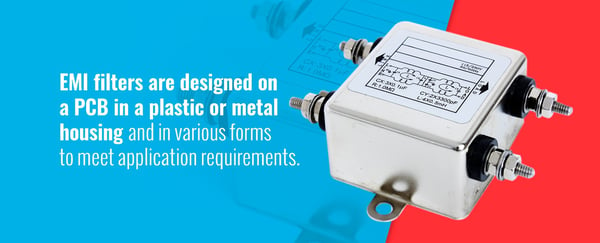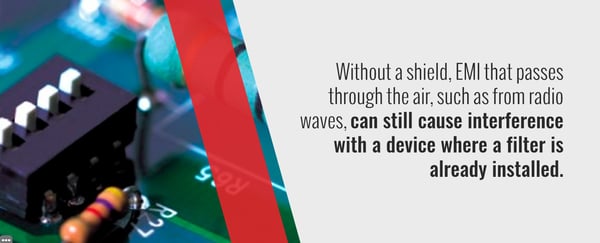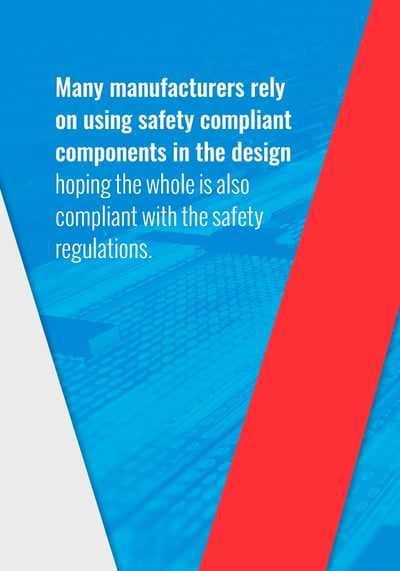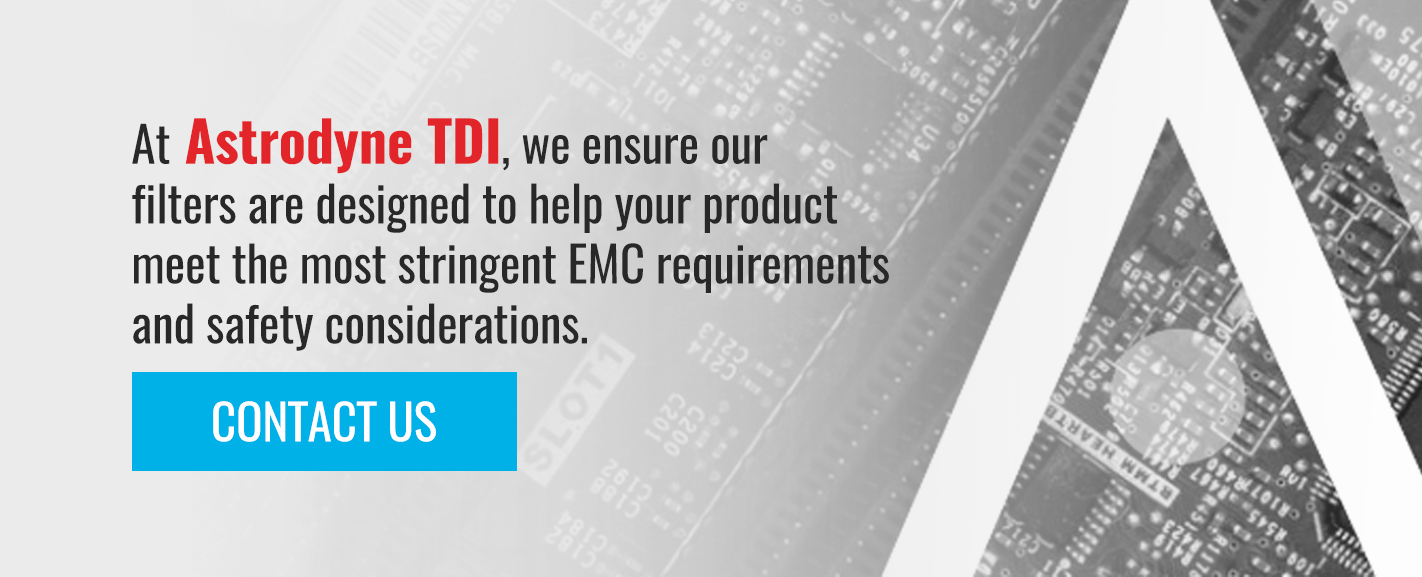RESOURCES
How to Design a Custom EMI Filter
An EMI Filter is required to protect electrical devices from electromagnetic interference (EMI). Filter design and selection depends on the EMI regulations, electrical specifications and other design requirements. In most cases, a standard off-the-shelf filter can meet the application requirements, but in many instances, a custom EMI filter solution becomes necessary to meet the application specific parameters.
Why You May Need Custom Design EMI Filter Solutions
The impact of electromagnetic interference widely varies. In some cases, EMI is simply an annoyance that causes interruptions. However, in critical applications such as the medical and military, such problems can be fatal.
EMI has two primary modes of propagation – conducted and radiated. Conducted EMI propagates through cables such as power lines, electrical wires and signal lines. Radiated interference travels through the air from sources such as appliances, motors, power supplies, cell phones and radio transmission equipment.
EMI occurs due to electrical or electronic switching which creates high frequency noise signals producing disruptions in the operation of an electronic device. For sound-producing devices, such as speakers, this could create static or crackling. Other electronics may experience interruptions, malfunctions or errors.
While electromagnetic emissions can interfere with the operation of electronic circuits, these can also cause an equipment to fail the EMI regulations. Should the unit suffer from radio frequency interference or fail EMI testing, a filter is required to mitigate the interference and bring the unit into compliance.
Electromagnetic compatibility (EMC) engineers attempt to reduce the disruptions and failures caused by both conducted and radiated interference and emissions.
In many cases, preventing interference is a mandate that must be complied with. For example, if a product is sold in the European union, it must comply with EMC Directive 89/336/EEC, which requires mitigation of emissions from the equipment and be immune against the external interference. In the US there are commercial (FCC part 15 & 18) and military standards that require similar EMI compliance.
In many instances, although US, EU and international EMC regulations don’t apply, the equipment may still need an EMI filter for immunity from the noisy environment. How to choose an EMI filter depends on several elements of design consideration such as current, voltage, frequency, space, interconnections and most importantly the required insertion loss.
For most applications, the standard products can meet the design requirements but in cases where standard products are not able meet the required design considerations, a custom design becomes necessary.
Custom EMI Filter Design Considerations
When outlining a custom EMI filter specification, apart from the basic electrical, function and mechanical requirements, it is critical to establish the product specific aspects of the device, such as real estate limitations, special environmental conditions and electrical requirements. Any specific application related requirements, such as adhering to medical or military design considerations, must also be established.

1. Real Estate Limitations
Space is a premium in most electrical and electronic designs. This can become a significant factor when designing an EMI filter. The available real estate and limitations can affect the size, weight and mounting.
Limitations in space, such as height and width, impacts the filter housing design. This require the use of a non-standard housing or fabricate one.
Any filter must have enough space inside to house the appropriate suppression components, such as capacitors and inductors. This becomes critical in noisy equipment that also have space limitations because the component selection becomes complicated. Three phases can further complicate the space constraints due to additional lines. High performance components such as high permeability cores and miniature capacitors become necessary which provide higher performance per unit space compared to conventional filtering components. This, however, can add other challenges such as core saturation and higher temperature rise. Special design techniques must be utilized to get over these roadblocks.
The mounting method greatly depends on the available space. Is it PC board mount or a standalone model? Discuss these requirements among other EMI filter design specification with the filter manufacturer when creating a custom filter.
2. Environmental Conditions
The environment in which an EMI filter is used also plays a key role in its design. For example, an EMC filter operating in a humid environment, will need better protection against moisture. This includes, but is not limited to special housing material, special potting compound and better sealing of interconnections.
Most standard filters are rated at 40-50°C ambient and 85-100°C operating. Higher temperature application will require high temperature rated components to achieve high ambient and operating temperatures.
In some applications such as aircraft, ground vehicles and certain industrial equipment, shock and vibration resistance may also be the critical criteria for EMI filter selection. Potting, threaded studs, connectors and sturdy mounting options impart additional safety to a filter in handling these conditions without impacting its intended life.
3. Electrical Requirements
The electrical requirements of a system play a significant role in the custom filter design. Some electrical requirements to consider include:

Resistor, inductor and Capacitor Values
The EMI (noise) signature of a system is a function of its electrical topology and is extremely complex to calculate. Any change in the electrical layout and/or parameters can alter the EMI signature. Two similar systems designed using different designs can have very different EMI footprint. This makes EMI a variable that is difficult to predict unless an EMI testing is conducted at each stage, which is not very common.
When the actual noise level of the equipment is not known, the first EMI test can bring surprises, whether that is very low noise levels or noise off the chart. The high noise can sometimes create a unique situation where most commonly available standard filters either don’t help or are overkill. This necessitates designing a custom electrical schematic. The inductor design and capacitor values are determined based on the insertion loss performance required.
Conducted or Radiated Attenuation
Is the attenuation required for conduced or radiated interference? Conducted interference propagates through the electrical cables, while radiated interference though electromagnetic fields. Most filters mitigate conducted interference only. To keep out radiated / electromagnetic waves, the filter must be paired with a shield. This can be achieved by one or all of the following:
- Putting a filter very close to the point of entry
- Using shielded input cables
- Using metal case filters
- Bulkhead mounting the filter
Without these, EMI can radiate through the air, similar to radio waves, and cause interference even when a filter is installed.
Common Mode vs. Differential Mode Noise
Whether you need to block common mode or differential mode noise depends on the device and its operation. Both common and differential mode currents can cause interference that may require filtration.
The common mode (CM) current refers to noise or signals that flow in the same relative direction in a pair of lines or all the lines.
The differential mode (DM) current refers to noise or signals that are either present in one of the lines or flow in opposite directions in a pair of lines.
Knowing the type of noise helps in choosing the correct EMI filter design. Most standard filter designs are common mode. When equipment fails EMI testing, knowing the type of noise (CM or DM) or failing frequencies can greatly help in suggesting an optimum solution. If the noise is common mode and a standard filter doesn’t help, either an alternate standard solution can be offered or the common mode components can be tweaked, as necessary. Where differential mode noise is an issue, more often a customized or custom solution is required especially if differential mode magnetics become necessary.
Leakage Current
Leakage current is a function of line to ground capacitances (direct and parasitic), line voltage and operating frequency.
IL = 2*π*f*Cy*V
Line to ground (Y) capacitors are a key component of any filter circuit. Bigger Y capacitors help the filter’s performance but also give higher leakage current. The leakage current is highly undesirable in certain applications such as patient connected medical devices as it creates a safety hazard for the patient. High leakage current can also damage other electronics in use, such as pacemakers, heart pumps etc. In many other cases, the equipment is required to meet leakage current limits to comply with agency safety requirements. As an example, high leakage currents can trip the GFCI causing disruption. This can be detrimental in areas such as MRI rooms or operation theaters.
This creates a unique challenge for an EMI filter designer. If the Y capacitor value is reduced to meet leakage current limits, the insertion loss performance suffers as well and, in many instances, this can result in equipment failing the emissions test. To make up for this, the other components must be adjusted which can lead to customization or fully custom design.
Considerations for Special Circumstances
Even when all the electrical requirements are fulfilled by a standard EMI filter, there can be other special requirements for specific applications. As an example, in the military and medical fields, EMI filters must meet additional electrical and safety requirements to prevent damage to themselves and the equipment. Factoring these situations into the design will ensure a correct filter selection and/or customization, if necessary.
A military EMI filter needs to meet the stringent military standards to survive harsh electrical, operational and environmental conditions.
Some of the military standards that are commonly considered include the following:
- MIL-HDBK-454B: general guidelines for electronic equipment
- MIL-HDBK-217F: reliability prediction of electronic equipment
- MIL-E-6051D: electromagnetic compatibility requirements, system
- MIL-STD-704A/B: aircraft electric power characteristics
- MIL-STD-1399A/B: electric power, alternating current, shipboard systems
- MIL-STD-810F: environmental engineering considerations and laboratory test methods
- MIL-STD-220: method of insertion-loss measurement
- MIL-STD-461G: requirements for the control of electromagnetic interference
- MIL-HDBK-5400: electronic equipment, airborne, general guidelines for ms27468 connector
- MIL-PRF-24308: connectors, electrical, d subminiature
- 4114504: filter box assembly, source control drawing
- 5131101: requirements for control of lead-free component finishes
- D13128-172: derating guidelines
- D20112-172: parts selection process
- D20200-172: workmanship manual
- IPC/EIA J-STD-001: requirements for soldered electrical & electronic
- IPC-A-610: acceptability of electronic assemblies
- MIL-PERF-15733: general specification for filters and capacitors, radio frequency interference
Commercial applications might require compliance to the standards released by following agencies which must be considered while designing the filter:
- IEEE
- ANSI
- SAE
Filters in medical applications need to be designed to support compliance to following standards:
- IEC60101-1-1
- IEC60101-1-2

How to Ensure Custom EMI Filter Solutions Are Compliant
Ensuring compatibility of EMI filters with various industry standards is more than a matter of just making the parts compliant. Using compliant parts in the design of a power line filter doesn’t necessarily mean that the whole is also compliant with regulations. It can only be ensured through the standards testing that the input filter design meets applicable regulations. The standards that a filter needs to adhere to depend on what it is used for. Military filters are commonly required to comply with the relevant requirements of MIL-STD-810, MIL-STD-1399-300A/B and MIL-PERF-15733. Commercial filters need to meet IEC, UL, CSA/UL, and CCC.
EMI standards are a bit different. These are system level specs. These define the limits of emissions, known as EMI noise, allowed for any system. The filter selection is based on how much noise a system generates in the conducted spectrum and how the much over the limit it is. The filter, by itself, doesn’t have to meet any EMI standard/directive, but the systems must. The EMI filter must be tested with the system to verify compliance.
When it comes to ensuring EMI compliance, work with a manufacturer that has EMC and filter design as a core competency and can either customize an existing design or design one from scratch to meet the requirements. Not all companies do, but Astrodyne TDI does.
Why Work With a Custom EMI Filter Manufacturer?
At Astrodyne TDI, we understand EMI. We have 3 in-house pre-compliance labs globally to test OEM equipment and create a baseline measurement. We have full filter design capability and thousands of standard products / designs which help us quickly select a standard solution, customize a design or build a custom. The equipment is retested to ensure compliance with at least 6-8dB margin. We have an agency-approved in-house safety lab as well that allows us to test and certify our new filter designs to relevant safety standards for US (UL 60939), Canada (CSA C22.2) and Europe (EN 60939-3). Due to our experience in designing and manufacturing customized and custom military, medical, aerospace, industrial and commercial EMI filters, we have developed the knowledge base for a myriad of standards that various industries must adhere to. This experience allows us to ensure that not only our filters fully comply with the applicable standards but also help bring your equipment into compliance.
If you need more information concerning how to design an EMI filter for your application or to request a quote, contact us at Astrodyne TDI. With customizable options that are compliant with industry standards, we can help you with the solutions you need for protecting your electronics and achieving EMI compliance.




